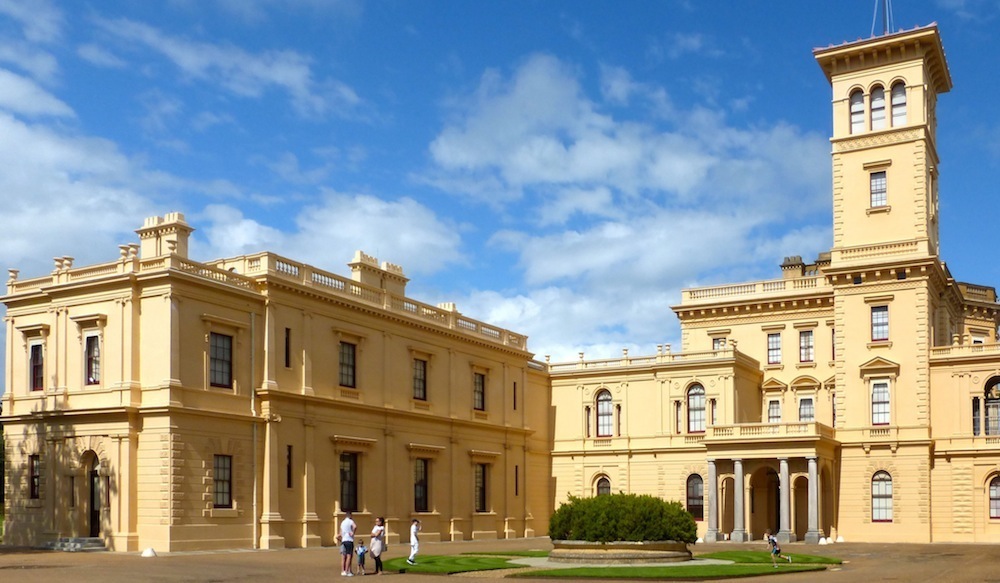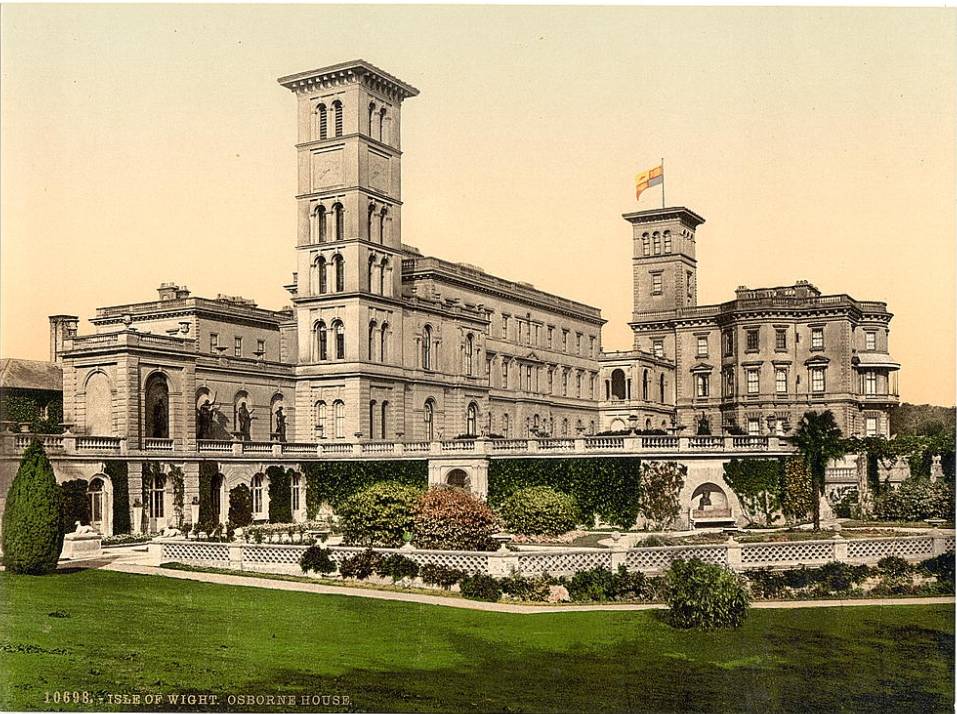Photographs by the author (with thanks to English Heritage for permitting photography) except for the last historic photomechanical print, which comes from the Library of Congress image collection (ref. LC-DIG-ppmsc-08987). You may use the images without prior permission for any scholarly or educational purpose as long as you (1) credit the photographer or the Library of Congress and (2) link your document to this URL or cite it in a print document. [Click on all the images to enlarge them.]
The Household Wing and Clock Tower

Osborne House, designed by Thomas Cubitt (1788-1855), with Prince Albert (1819-1861), and built 1845-51, with the important later addition of the Durbar Wing, 1890-91, by John Randall Mann (1828-1918). This Grade I listed building is of brick, with a warm-coloured cement render or stucco that makes it look like stone. It was Queen Victoria's much-loved family home and retreat at East Cowes, on the Isle of Wight. Shown above is the nine-bay Household Wing and adjacent clock tower, with the lower terrace gardens and Andromeda Fountain (by John Bell) below.

"Boar and hound" entrance to the Household Wing.
This wing, which provides the most impressive frontage for the house, was actually the second part of it to be completed, dating from 1847-51. As its name suggests, it was for the household retinue and everything concerned with the running of the house. The Calydonian Boar at its main entrance replaces one destroyed in 1918 (Turner 3).
Behind and parallel to the Household Wing is the Main Wing, with the important linking Grand Corridor, which more than lives up to its name because it serves also as an impressive sculpture gallery, with niches, cabinets, busts and so on. Just off this Corridor are the Queen's Audience Room and the large Council Room, where her Privy Council would meet; the latter was also used for entertainments.
The Pavilion


Left: The Pavilion with the flag tower, which has an observation room at the top, seen here at the far end of the Household Wing. Right: This view, taken a little closer to the clock tower, shows the part of the terrace below that is being used as a restaurant.
After the original Georgian mansion on the site was demolished, the first part of the new one to be built was the Pavilion, the heart of the house with the family's private rooms. The Pavilion sported that important marker of royal residence, a flag tower. It was completed in 1846. Prince Albert "preferred Royal Engineers and builders to architects" (Turnor 86) for his building projects, most probably because he could have more control over the planning, and he and Cubitt got on well together: the Prince "provided the vision and exercised a strong influence on the house's design and construction in an Italian Renaissance palazzo style. The house was clad in the builder's Belgravia fashion, which conformed to the 'client's brief'" (Stewart 75).


Left: The Pavilion with its bays facing the gardens on two sides. Right: The Pavilion frontage on the west, facing the carriage ring, with the grand entrance.
On the right, the bays of the Pavilion belonged to the drawing room on the ground floor, the Queen's sitting room on the first floor, and above that, the nursery bedroom. The bays facing the fountain were the windows of the dining room, with Queen Victoria's bedroom on the first floor, and, on the third floor, the nursery sitting room. The west front of the Pavilion faces the carriage drive, and has the main entrance with a small flight of steps and a columned, Portland stone porch. Prince Albert had originally planted heather in the raised circular cement flowerbed in the middle of the drive (Turner 5, 3). Note the lamp-post which has dolphins at the base, in acknowledgement of the house's closeness to the sea.
The Durbar Wing

The Durbar wing on the left of the Pavilion, was added later by Queen Victoria.
The Durbar wing was added to the original L-shaped complex in 1890-91. Standing opposite the Grand Corridor linking Household Wing, the Main Wing and the Pavilion, it forms another side to the courtyard here. Mann, who had served his apprenticeship with Cubitt, and was now Clerk of Works here, designed the new wing very much on the lines of the rest (see Lloyd and Pevsner 202, 205). The interior, however, is a different matter. This was decorated in an exuberantly exotic style by Bhai Ram Singh and John Lockwood Kipling.
In recent years the house has been beautifully restored, and now looks very much as it did in the nineteenth century (see adjacent photograph). Inside, too, much has been done to redecorate and restore the rooms and also the grounds to their original appearance (see Turner 52).

Photomechanical print, photocrom colour, c. 1890-1900, from a series of "Views of England" (see headnote).
Related Material
- Osborne House: Interior of Pavilion
- Osborne House: Interior of Household Wing and Main Wing
- Osborne House: Interior of Durbar Wing
- Osborne House: Terraces and Grounds
- Sculpture of Eos on the Pavilion terrace
- Walled Garden, Osborne
- Swiss Cottage, Osborne
- Summer house / Children's toolshed, Osborne
- Children's museum, Osborne
- Children's Victoria Fort and Albert Barracks, Osborne
- Queen Victoria's bathing machine at Osborne beach
Bibliography
"The History of Osborne House: A Glimpse into the History of a Royal Palace." English Heritage. Web. 11 April 2012 (the website has since changed).
Lloyd, David W., and Nikolaus Pevsner. Isle of Wight. Buildings of England series. New Haven & London: Yale University Press, 2006.
"Osborne House, East Cowes." British Listed Buildings. Web. 11 April 2012.
"[Osborne House, Isle of Wight, England]." Library of Congress. Web. 11 April 2012.
Stewart, Jules. Albert: A Life. London & New York: I. B. Tauris, 2011 [Review].
Turner, Michael. Osborne. Rev. reprint. London: English Heritage, 2016.
Turnor, Reginald. Nineteenth Century Architecture in Britain. London: Batsford, 1950.
York, HRH The Duchess of, with Benita Stoney. Victoria and Albert: Life at Osborne House, London: Weidenfeld and Nicolson, 1991.
Last modified 10 September 2017